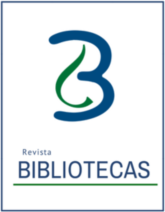The Linked Data and the Discovery of Links in the Bibliographic Universe
DOI:
https://doi.org/10.15359/rb.37-1.3Keywords:
Linked data, Bibliographic data, Bibliographic universe, Semantic webAbstract
The bibliographical universe is a complex context and is in a constant evolution. It is formed by entities, data and relations of bibliographical affairs. Librarianship, or library science, has studied this universe from the documentary organization perspective. It’s been identified that the information technologies have influenced deeply in this universe, causing the appearance of new sources giving the remarkable importance of the information that conforms them. The bibliographical universe and the semantic web are parallel environments that can count with connection patterns. To this effect, it is necessary for the library regulations to be adapted to the early semantic web. Linked Data is a model for the generation, publication and entailment of structured data in the web. This model has been identified by the librarian community and has been adapted to the BIBFRAME and LRM-IFLA conceptual models. Therefore, the focus of this work remains on analyzing the application of Linked Data elements to identify the patterns that allow the discovery of existent data links in the library universe. The obtained findings of the application and integrations of Linked Data principles in the librarian register are presented, and the derivative concept of linked bibliographical data is explained.
References
Berners-Lee, T. (2006). Linked data. Recuperado de https://www.w3.org/DesignIssues/LinkedData.html.
Boehr, D. y Bushman, B. (2018). Preparing for the Future: National Library of Medicine's® Project to Add MeSH® RDF URIs to its Bibliographic and Authority Records. Cataloging & Classification Quarterly, 2 (56): 262-272.
Casalini, M. (2017). BIBFRAME and Linked Data practices for the stewardship of research knowledge. Trabajo presentado en DH. Opportunities and Risks. Connecting Libraries and Research. Alemania, Berlin, 15-17 de agosto.
Dousa, T. (2017). E. Wyndham Hulme's Classification of the Attributes of Books: On an Early Model of a Core Bibliographical Entity. Knowledge Organization, 8 (44): 592-604.
Dunsire, G. y Willer, M. (2011). Standard library metadata models and structures for the Semantic Web. Library Hi-Tech News, 3 (28): 1-12.
Dunsire, G. (2014). The Role of ISBD in the Linked Data Environment. Cataloging & Classification Quarterly, 8 (54): 855-868.
Elsayed Abdelaziz, E. y Saleh Mesbah, K. (2018). Proposal for Implementing Linked Open Data on Libraries Catalogue. Trabajo presentado en el 84th World Library and Information Congress de IFLA. Kuala Lumpur, Malaysia, 24-30 de agosto.
Hagler, R. (1997). The bibliographic record and information technology. United States: ALA.
Niu, J. (2013). "Hierarchical Relationships in the Bibliographic Universe". Cataloging & Classification Quarterly, 5 (51): 473-490.
Open Data Commons. (2018). Legal tools for Open Data: Licenses. Recuperado de https://opendatacommons.org/licenses/
Pastor Sánchez, J. (2018). SKOS. Recuperado de http://skos.um.es/acerca/index.php
Qiang, J., Hahn, J. y Croll, G. (2016). BIBFRAME Transformation for Enhanced Discovery. Library Resources & Technical Services, 4 (60): 223-235.
Rodríguez García, A. (2012). Las dimensiones de los datos: una combinación de tradiciones bibliográficas y oportunidades de cambio, en Oportunidades y retos en la formación, investigación y aplicación del conocimiento bibliotecológico, compilado por Jaime Ríos Ortega y César Augusto Ramírez Velázquez, 209-228. México: UNAM.
Rollit, K. (2014). MARC21 to Bibframe: outcomes, possibilities and new directions. New Zealand Library & Information Management Journal, 1 (55): 16-19.
Smiraglia, R. y Leazer, G. (1999). Derivative Bibliographic Relationships: The Work Relationship in a Global Bibliographic Database. Journal of the american society for information science, 6 (50): 493-504.
Smiraglia, R. (2001). The nature of a work: implications for the organization of knowledge. London: Scarecrow Press.
Tanja, M., Zumer, M. y Aalberg, T. (2012). Presenting and Exploring the Complexity of Bibliographic Relationships. Lecture Notes in Computer Science, (7634): 63-66.
Tillet, B. (2001). Bibliographic relationships, en Relationships in the organization of knowledge, de Carol A. Bean y Rebecca Green, 19-35. Netherlands: Kluwer Academic Publishers.
Tillett, B. (1991). A taxonomy of bibliographic relationships. Library Resources & Technical Services 2 (35): 150-158.
Vellucci, S. (1997). Bibliographic relationships. Trabajo presentado en la International Conference on the Principles and Future Development of AACR, 23- 25 de Octubre.
W3C. (2011). Library Linked Data Incubator Group Final Report: W3C Incubator Group Report. Recuperado de https://www.w3.org/2005/Incubator/lld/XGR-lld-20111025/
W3C. (2014). RDF Schema 1.1: W3C Recommendation. Recuperado de https://www.w3.org/TR/rdf-schema/
W3C. (2016). Web accesibility initiative. Recuperado de https://www.w3.org/WAI/intro/usable
W3C. (2012). Incubator Activity. Recuperado de https://www.w3.org/2005/Incubator/lld/
Wilson, P. (1989). The second objective, en Conceptual foundations of descriptive cataloging, editado por Elaine Svenonius, 5-16. San Diego: Academic Press.
Wood, D., Zaidman, M. y Ruth, L. (2014). Linked data: structured data on the web. Estados Unidos de América: Manning.
Zapounidou, S., Sfakakis, M y Papatheodoru C. (2017). Preserving Bibliographic Relationships, en Research and Advanced Technology for Digital Libraries, compilado por J. Kamps, G. Tsakonas, Y. Manolopoulos, L. Iliadis y I. Karydis, 15-26. Springer.
Downloads
Published
How to Cite
Issue
Section
License
Bibliotecas provide immediate open access to their content, based on the principle of facilitating research to the public free of charge and free of charge to promote the global exchange of knowledge.
The journal Bibliotecas is a publication hosted by a public higher education institution, which is supported by public resources. Since its inception, the magazine has offered all its contents free of charge without any restriction on the rights of: reading, downloading and printing in full text. Works published in libraries may be analyzed, quoted and reproduced in whole or in part, mentioning the original source.
The journal Bibliotecas is licensed under the Creative Commons Attribution - Non-Commercial - Share Equal, 4.0 International license; therefore, it is allowed to: share, copy and redistribute the material in any medium or format.

Este obra está bajo una licencia Creative Commons Atribución-NoComercial-CompartirIgual 4.0 Internacional.








